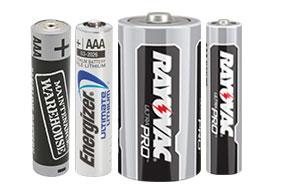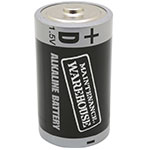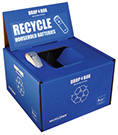Battery Buying Guide
Battery-operated devices are increasingly popular in our portable and wireless world. Stay powered up with the right type of batteries for all your equipment, including remotes, clocks, flashlights, smoke alarms, and more. HD Supply stocks the most common battery sizes from quality battery brands like Energizer ® , Rayovac ® , and Duracell ® , as well as our exclusive brand of HD Supply batteries.
Types of Batteries

General use batteries are classified into two groups – primary and secondary.
- Primary, or disposable, batteries operate on a single charge and are not rechargeable. You should never attempt to recharge a disposable alkaline battery.
- Secondary, or rechargeable batteries, can be discharged and recharged multiple times. Always fully charge a secondary battery before its first use.
Alkaline

Invented in 1949, alkaline batteries account for about 70% of all battery purchases. Based on zinc chemistry instead of acidic properties, alkaline batteries have a high energy density and long service life. Alkaline batteries typically produce 1.5 volts when fresh and are ideal for portable and low-drain devices such as clocks, remote controls, and flashlights. Premium alkaline batteries such as long-lasting Duracell Quantum and Rayovac Fusion batteries are ideal for high-drain devices like smoke detectors, carbon monoxide (CO) alarms, digital cameras, wireless keyboards, and two-way radios.
Carbon Zinc

Carbon zinc batteries are one of the least expensive general use batteries available, but aren't as powerful as alkalines and have a shorter shelf life. Carbon zinc batteries are useful for low-drain or intermittent use devices including remotes, flashlights, and clocks. Carbon zinc is usually the type of battery included with the manufacturer's product.
Lantern

Six-volt lantern batteries are primarily used in flashlights or lanterns. They are typically an alkaline or carbon zinc battery and offer reliable performance.
Lithium

Though more expensive, lithium batteries have a significantly longer life span than general use alkalines. Lithium batteries are ideal for high-drain devices such as smoke detectors, CO alarms, emergency lighting, and more.
Rechargeable

Rechargeable batteries can, of course, be recharged again and again. Rechargeable batteries have a higher upfront cost than disposable batteries, but will save you money over time. You can also reduce waste and lower your environmental impact by using rechargeable batteries. Be sure to purchase a good battery charger so batteries stay charged and ready for the day's work.
Keep Extra Batteries in Emergency Kits
Storms, fires, and other events can cause unexpected and prolonged power outages. The American Red Cross recommends that you keep assorted battery sizes in your emergency preparedness kit for radios, flashlights, two-way radios, tools, etc.
Stock Up on Replacement Batteries

Some residents disable smoke alarms and carbon monoxide (CO) detectors in their units by removing the batteries. Guests have also been known to take batteries from remote controls and use them in other devices. Batteries also simply drain down and discharge over time. Keep extra AA and 9 volt batteries in stock to quickly replace any missing, weak, or dead batteries ahead of annual fire inspections and to minimize any inconvenience to residents and guests.
Battery Storage & Care
Batteries last longer and perform better when you follow these tips:
- Use the correct battery size and type as recommended by the device manufacturer
- Store batteries at room temperature in a dry location
- Keep batteries in the original packaging until ready for use
- Promptly remove dead or weak batteries from devices
- Never mix old and new batteries
- Remove batteries from devices that go unused for a long time
Common Battery Sizes
The most widely used battery sizes are AA, AAA, C, and D. Have you ever wondered how battery sizes were determined? In the early 1900s, battery manufacturers and government agencies developed uniform specifications for battery cell size and minimum performance criteria. Naming conventions were based off the alphabet, with the smallest cells being AA and AAA and larger ones C and D sizes. B size batteries were once available, but were eventually phased out in America.
Battery Disposal

Many alkaline and heavy-duty batteries can be safely disposed of with normal waste in most areas; however, some cities and states may require you to recycle batteries. Always check with your local and state officials to stay in compliance with battery disposal regulations.
HD Supply helps make recycling easy with our battery recycling kits. Simply fill the container with old batteries, seal it up, and ship batteries to the recycling center.
